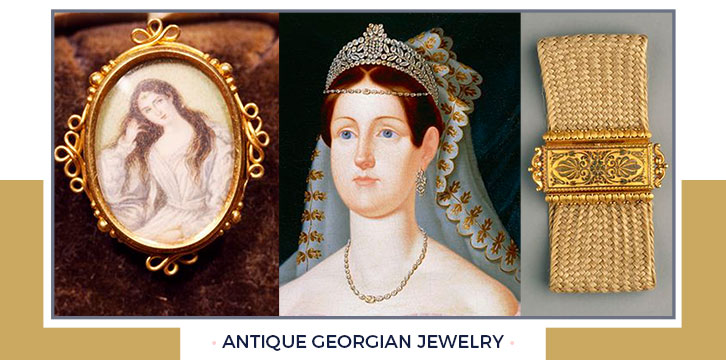The term “Georgian” is used to refer to an era of antique jewelry design that occurred during the 18th and 19th centuries. Though Georgian jewelry refers specifically to jewelry made during this time period, the phrase also incorporates certain design trends that were common at the time.
Most antique jewelry is classified into different eras or periods, so becoming familiar with each one will help when looking for particular pieces. Jewelry collectors covet heirlooms from the Georgian Era because it is one of the earlier eras and jewelry is often handwrought and rare.
These facts about Georgian jewelry history will help you appreciate the subtle nuances we come to love in vintage and antique jewelry.

1. Georgian Era Jewelry is Centuries Old
The Georgian Era took place from 1714 to 1837 during the reign of George I, George II, George III, George IV, and William IV, who were Hanoverian kings of the United Kingdom.
2. The Georgian Era Was Long
The Georgian Era lasted such a long span of time that included multiple generations, so there are actually many different styles and trends embedded throughout the era.
Jewelry historians break down Georgian Era jewelry into three periods: Early, Mid, and Late.
3. Georgian Jewelry is Not Just from England
Despite being a time marker of British history that is named after reign of five English Kings, Georgian era jewelry is by no means limited to jewelry from England. As the United Kingdom expanded its grip on the rest of the world, so too did the rest of the world impact those living and creating in the United Kingdom.
Whether it was the American Revolution, the writing of Jane Austen, or the life and death of Marie Antoinette, many political and social movements widened the scope of this era’s influence. As a result, we see similar jewelry trends and design styles from Georgian jewelry showing up all over Europe, America, and Great Britain.

4. Georgian Jewelry Was Not Limited by Class
Despite being a war-ridden era, this time period was also quite progressive. Prior to this era, jewelry was mainly limited to wealthy aristocrats. This is so true in fact that there were laws known as sumptuary laws that prohibited the wearing of jewelry by the lower classes!
The Georgian Era, especially the Late Georgian Era, changed how people look not only at jewelry but class structure. This was the first time in this type of aristocratic system that the middle class had accessible and accepted jewelry to wear. This may not seem that significant, but in light of all the other social reform and revolutions happening, it only makes sense that more people began embracing the finer things in life.
5. Georgian Jewelry is Rarer Than Victorian Jewelry
Even though there is significantly more Georgian jewelry out there than jewelry pre-dating 1714, it is still considered quite rare in the antique jewelry world, especially in the United States. You are more likely to find Late Georgian jewelry than you are able to find anything earlier than 1750. This is not only because of the loosening up of sumptuary laws after 1750 but also because styles changed. A lot of the earlier jewelry was recycled as trends went in and out of fashion.
Your best bet to find a quality piece of Georgian Jewelry is to look in parts of Europe and the United Kingdom where the concentration of jewelry production was at its highest.

6. There are Many Georgian Era Jewelry Trends
Among the many design styles, some common types of Georgian jewelry include cameos, mourning jewelry, lover’s eye jewelry, hair jewelry, chatelaines, and cannetille jewelry.
Som common Georgian jewelry motifs include lover’s knots, foilage, halo settings, leaves, and script.
7. Georgian Jewelry Metal Content Was Limited
Jewelry from the Georgian Era was crafted primarily in high karat yellow gold of at least 18K and silver. Steel and iron jewelry were also popular.
There was no platinum or white gold in Georgian era jewelry. Don’t expect Georgian Era jewelry to have metal markings, especially if it was made in the United States because gold hallmarks were not regulated until much later.
8. There are “Fake” Georgian Era Stones
Yes, simulated stones existed hundreds of years ago! Even though much of the jewelry was handmade, the supply of stones and metals was not as limited as you might think.
Many glass “paste” stones were used. Other popular stones of the era include topaz, garnet, diamond (rose cuts and mine cuts), emerald, ruby, coral, and pearls.

9. Georgian Jewelry is Usually Always Handcrafted
The machines that helped produce large quantities of Victorian jewelry were not available to Georgian Era goldsmiths. Each piece was entirely hand forged during the Early Georgian years. Even though mid to late Georgian jewelry had the advantage of mills that would roll gold out into sheets instead of having to hand hammer out the gold, the process of crafting jewelry was still very labor intensive.
10. Beware: Georgian Jewelry is Reproduced
Due to the value of Georgian Era jewelry, there are many makers of fake Georgian jewelry out there. Their jewelry is often made with silver, yellow gold, and rose cut diamonds. The silver is artificially aged to make the piece appear old.
Some sellers will make you aware that the item is a reproduction. Other sellers will try to deceive you with words like “Georgian-style” and the worst sellers will blatantly lie and tell you the jewelry is old when it is not. Your best bet is to buy from a reliable and knowledgeable antique jewelry dealer. Also, if something is 250 years old and has no repairs, wear, or imperfections, it is likely a reproduction.
Related Articles
